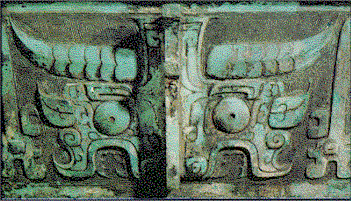Excerpt from Li Zehou’s
The Path of Beauty: A Study of Chinese Aesthetics

About the taotie:
". . . .Most of the bronze objects of the Shang and Zhou were ritual vessels used in sacrificial ceremonies to make offerings to one’s ancestors, or were inscribed with records of military exploits and victories. It was also the custom in those days to slaughter prisoners of war for sacrificial purposes, and to kill and even eat one’s enemies. The creed then was: ‘He who is not of my own clan must be an enemy at heart.’ The man-eating taotie was therefore a supremely appropriate symbol of those times.
"According to Lu’s Spring and Autumn Annals: Prophecy, ‘The taotie on Zhou bronzes has a head but no body. When it eats people, it does not swallow them, but harms them.’* It is hard to explain what is implied in this, as so many myths concerning the taotie have been lost, but the indication that it eats people accords fully with its cruel, fearful countenance. To alien clans and tribes, it symbolized fear and force; to its own clan or tribe, it was a symbol of protection. This religious concept, this dual nature, was crystallized in its strange, hideous features. What appears so savage today had a historical, rational quality in its time. It is for precisely this reason that the savage old myths and legends, the tales of barbarism, and the crude, fierce, and terrifying works of art of ancient clans possessed a remarkable aesthetic appeal. As it was with Homer’s epic poems and African masks, so it was with the taotie, in whose hideous features was concentrated a deep-seated historic force. It is because of this irresistible historic force that the mystery and terror of the taotie became the beautiful—the exalted."
*footnote by Li Zehou: "Some scholars consider that the meaning of taotie is not ‘eating people’ but making a mysterious communication between people and Heaven (gods)."
This excerpt is from The Path of Beauty: A Study of Chinese Aesthetics by Li Zehou, translated by Gong Lizeng.New York: Oxford University Press, 1994. pages 30-31. The hard-bound copy has some of the most beautiful reproductions available. The text should be required reading for anyone interested in Chinese culture.
Return to Study Guide for Shang and Zhou Dynasties